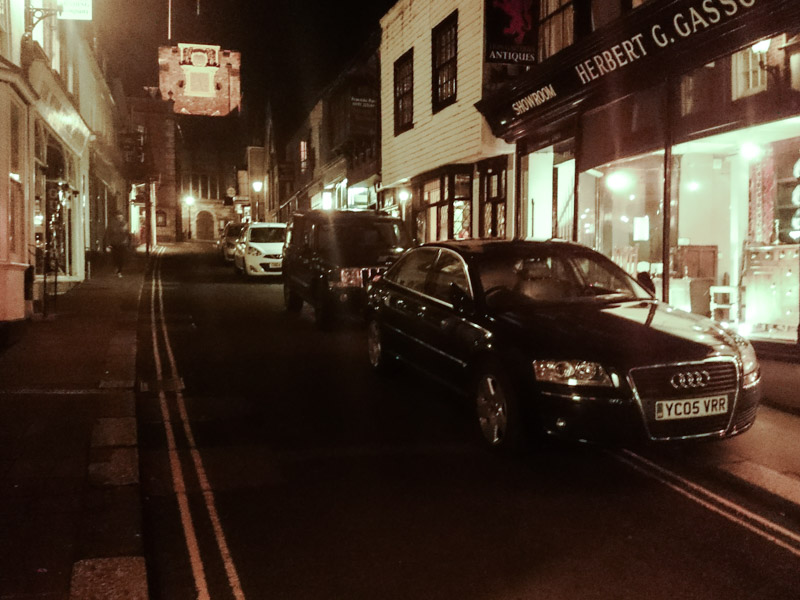As the town became packed for the school half-term holidays, motorists parked overnight where they thought they could get away with it, as the night-time photo above in Lion Street, between the High Street and the Town Hall, shows.
But the end of the main holiday period has also resulted in an outburst of scaffolding for urgent repairs, as it does in many historic holiday towns with narrow streets, and overnight parkers representing a hazard where they block access to emergency vehicles – such as at the top of Lion Street in the above picture.
However local police have said that parking issues are a low priority for them unless they present an immediate danger, particularly since parking offences became decriminalised. They are now only a civil offence.
Also government cuts in funding mean that parking has dropped off the police agenda, and in Rye, the station is open only for limited hours, while the number of officers and support staff has also been considerably cut back.
In most areas therefore, parking problems have become an issue for traffic wardens to sort out, though often not at night time.
In Rye, bollards have been used in a few places in the past, such as lower parts of The Mint, to prevent problem parking, but this is not always practical everywhere – particularly if the fronts of houses are not in a straight line and the pavement is of varying widths. So for example, a delivery van parked in an unbollarded higher part of The Mint brought traffic, including a Rye Community Transport mini-bus, to a complete halt one day this week.
However, despite bollards being used sometimes, the town council recently parked a proposal to line all, or part of, Lion Street with them. This was proposed to deal, in particular, with deliveries being made to the George Hotel in Lion Street, despite a loading bay being especially introduced in front of the hotel in the High Street for their deliveries .
Instead, the council will be giving further consideration next Monday to CCTV (close circuit television) in Lion Street and some towns have used this with some success to resolve problems. But this may have been before police powers became more limited, and before there were much fewer police to enforce the powers they do have.
And, if motorists are aware of police policy and the likelihood of them taking or not taking action, the potential threat posed by CCTV may vanish. For example, in many areas police choose to regard many burglaries as victimless crimes, do little – if any – investigation, and refer people to their insurers – with the alleged consequence that burglaries are on the increase, as well as insurance charges.
However CCTV might help traffic wardens to enforce CPE (Civil Parking Enforcement) which both East Sussex County Council and Rother District Council (RDC) seem to be moving reluctantly towards – and the town council might have to sign up to CPE, if all other options prove unsatisfactory or impossible.
But, if CPE is introduced by RDC, that in turn may lead to measures which place controls on deliveries, except in exceptional circumstances, and partial pedestrianisation – either in terms of hours, or particular streets, or even particular users. Ashford, Hastings and Eastbourne town centres have variations on the sort of pedestrianisation that can be introduced, and historic Cambridge has rising bollards which allow some access by some vehicles at certain times in the busiest and most overcrowded parts.
However, if CCTV has its limitations, the town council on Monday may go back to considering bollards in Lion Street (possibly costing up to £37,000) unless it bites on the bullet and decides it must agree to CPE.
Photo: Rye News library




They are not particularly elegant, and the Rye Conservation Society will choke on their aspic, but a few yellow boxes painted at important junctions along the high street would help. Most people have a higher regard for them than double yellows, and it would also put an end to the rash of blue badge holders who are particularly guilty of stupid parking, particularly outside the Edinburgh wool shop, making turning into Market St difficult. I acknowledge they have the right to park on doubles, but not when it causes obstructions. Sadly many are totally oblivious.
Peter is lucky enough to be healthy , so he has absolutely no idea of the difficulties that Blue Badge holders experience when normal yellow line restrictions are ignored by so many. The high Street shop keepers should also lament this situation, as visitors , particularly blue badge holders, can no longer use our local town
Ted